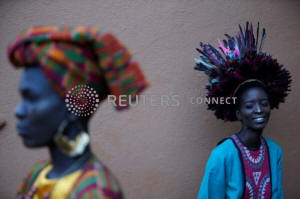|
From birth to death: an archive of
vanishing African rituals seeks a home
 Send a link to a friend
Send a link to a friend
 [March 05, 2019]
By Katharine Houreld [March 05, 2019]
By Katharine Houreld
NAIROBI (Reuters) - Whirling masked spirits
clad in raffia and laughing children daubed with clay dance across the
pages of "African Twilight", the latest book by two photographers
documenting rapidly vanishing rituals across the continent.
Carol Beckwith and Angela Fisher have traversed 44 of Africa's 54
countries over four decades, documenting rituals used to mark milestones
such as birth, death, and courtship, the graduation of girl to woman or
the moment a warrior becomes a respected elder.
Now their archive - comprising more than a million images, hundreds of
artifacts and field diaries, and thousands of hours of video - is
looking for a home.
They want the collection to go to a university in Africa or some other
venue that will guarantee access to African artists, historians and
researchers.
"This record of Africa won't be taken again. It can't be taken again
because 40 percent of it is already lost," said Fisher, a vivacious
Australian draped in beads and red chiffon for their book launch in
Nairobi on Sunday.

Heat lightning flashed across the sky as models, acrobats and dancers
showcased traditional music and textiles at the event at Africa Heritage
House, a private museum. But conflict, climate change, and the spread of
technology are erasing or transforming many such customs.
LOSS OF IDENTITY
In South Sudan, decades of war has devastated traditional Dinka culture,
said Beckwith, a petite, curly-haired American. Few now can make the
beaded corsets whose patterns and colors would tell you the life story
of its wearer.
In Ethiopia, desertification and land grabs are pushing nomads south
into farming lands or towns. Samburu elders in Kenya worry that
youngsters enamored of cell phones and city life no longer care for
time-consuming social ceremonies and the obligations they entail.
[to top of second column]
|

Models wait behind the scenes before a fashion show featuring
African fashion and culture during a gala marking the launch of a
book called "African Twilight: The Vanishing Rituals and Ceremonies
of the African Continent" at the African Heritage House in Nairobi,
Kenya March 3, 2019. REUTERS/Baz Ratner

"It's really important for change to happen, but ... in a way that
works without losing your identity," said Fisher.
Encouraged by conservationists, one Maasai community in Kenya
changed from lion-hunting to athletic games as a way of proving male
prowess, she said. The Wodaabe people in Niger still stage male
beauty pageants famed for their use of make-up and grimaces.
The photographers' friend Nike Okundaye, a Nigerian chief and
textile artist, is trying to revive the laborious methods for dying
patterned indigo clothes, a tradition handed down from her
great-great-grandmother.
Women once used the cloth - Nigeria's "color of love", Okundaye says
- to flaunt matrimonial harmony. But the months-long process to
produce a piece makes it too expensive for most consumers, so now
her work hangs in Washington's Smithsonian Museum and is pictured in
the pages of Beckwith and Fishers' books. Okundaye has been working
with them since 1967, she said.
"Carol loved the culture and Angela loved the tradition," Okundaye
said. "We hope their photographs will inspire a new generation."
(Editing by Gareth Jones)
[© 2019 Thomson Reuters. All rights
reserved.]
Copyright 2019 Reuters. All rights reserved. This material may not be published,
broadcast, rewritten or redistributed.
Thompson Reuters is solely responsible for this content.
 |